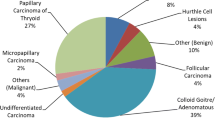Abstract
Many countries and medical associations have developed guidelines for the management of thyroid pathology, including the surgical procedures and diagnostic preoperative and intraoperative procedures. As clearly stated in most guidelines, the aim of any diagnostic procedure is to clarify the nature of the thyroid lesion and properly direct the correct management. Our aim is to provide evidence to support or reject the intraoperative use of frozen section during the surgical management of thyroid pathology. In the past, frozen section was a basic tool in thyroid surgery since the preoperative diagnosis was not that accurate, and given that many different procedures were used for the surgical management of benign and malignant thyroid lesions, the decision as to the appropriate surgical technique was based on the results of the frozen section. With the evolution of ultrasonography and the extensive use of fine needle aspiration FNA cytology, the value of frozen section was soon questioned. Eventually, FNA proved to be sufficiently sensitive as to replace the frozen section in almost 99% of cases, and it provided a safe preoperative diagnosis. Today, almost all endocrine surgery societies agree that FNA should be the initial diagnostic procedure during the assessment of thyroid pathology, and this is recommended in their national guidelines. Based on the current literature, there are certain pertinent facts concerning frozen section:
-
a.
In thyroid surgery, frozen section is not always conclusive.
-
b.
In thyroid surgery there are still debatable issues concerning both the type of surgery and the extent of surgery.
-
c.
The basic question lies in whether frozen section can alter the surgical plan and in what way.
If the operation to be performed is total thyroidectomy, it is unlikely that the results of frozen section will alter the surgical plan since it is a radical operation adequate for both benign and malignant thyroid lesions.
-
FNA today is the indicated initial diagnostic method and should be used in all cases to obtain preoperative diagnosis (2A) (NCCN v.2013)
-
Frozen section can be used in addition to FNA only if the results will alter the operative plan or the extent of the operation.
-
Frozen section should not be used to distinguish benign from malignant follicular lesions or Hurthle cell tumours (Ib, A).
Similar content being viewed by others
References
Musholt TJ, Clerici T, Dralle H, et al. German Association of Endocrine Surgeons practice guidelines for the surgical treatment of benign thyroid disease. Langenbecks Arch Surg 2011;396:639–49.
Yeung MJ, Serpell JW. Management of the solitary thyroid nodule. Oncologist 2008;13:105–12.
Anton RC, Wheeler TM. Frozen section of thyroid and parathyroid specimens. Arch Pathol Lab Med 2005;129:1575–84.
Cetin B, Aslan S, Hatiboglu C, et al. Frozen section in thyroid surgery: is it a necessity? Can J Surg 2004;47:29–33.
Huber GF, Dziegielewski P, Matthews TW, et al. Intraoperative frozen-section analysis for thyroid nodules: a step toward clarity or confusion? Arch Otolaryngol Head Neck Surg 2007;133:874–81.
Hamburger JI, Hamburger SW. Declining role of frozen section in surgical planning for thyroid nodules. Surgery 1985;98:307–12.
Bahn RS, Burch HB, Cooper DS, et al. Hyperthyroidism and other causes of thyrotoxicosis: management guidelines of the American Thyroid Association and American Association of Clinical Endocrinologists. Endocr Prac. 2011;17:456–520.
Cooper DS, Doherty GM, Haugen BR, et al. Revised American Thyroid Association management guidelines for patients with thyroid nodules and differentiated thyroid cancer. Thyroid 2009;19:1167–214.
Dralle H, Musholt TJ, Schabram J, et al. German Association of Endocrine Surgeons practice guideline for the surgical management of malignant thyroid tumors. Langenbecks Arch Surg 2013;398:347–75.
Huang TW, Lai JH, Wu MY, et al. Systematic review of clinical practice guidelines in the diagnosis and management of thyroid nodules and cancer. BMC Med 2013;11:191.
Pacini F, Castagna MG, Brilli L, et al. Thyroid cancer: ESMO Clinical Practice Guidelines for diagnosis, treatment and follow-up. Ann Oncol. 2012;23(Suppl 7):vii110–9.
Pitoia F, Ward L, Wohllk N, et al. Recommendations of the Latin American Thyroid Society on diagnosis and management of differentiated thyroid cancer. Arq Bras Endocrinol Metabol 2009;53:884–7.
Author information
Authors and Affiliations
Corresponding author
Rights and permissions
About this article
Cite this article
Lanitis, S., Sourtse, G., Kouloura, A. et al. Thyroid surgery: Does frozen section have a role? If yes, in which cases?. Hellenic J Surg 87, 31–33 (2015). https://doi.org/10.1007/s13126-015-0175-8
Received:
Accepted:
Published:
Issue Date:
DOI: https://doi.org/10.1007/s13126-015-0175-8



